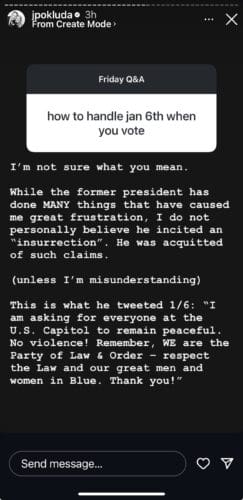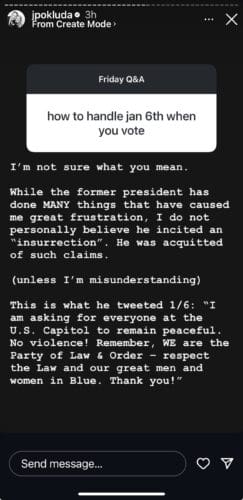
A common misconception about media integrity assumes journalists must attempt to cover all sides of a given story to be objective. I wrote about this earlier in the year in a guest editorial for Baptist News Global, proposing that the goal isn’t to alleviate bias but to identify and name our biases.
Even so, fairly covering all sides of a political story was easier in more precedented times. Whether it be the foreign policies of Mitt Romney and Barack Obama or the marginal tax rate that George W. Bush or John Kerry proposed, the nearness of their positions allowed more civil reporting.
Even with more contentious issues like abortion, each candidate’s clear articulation of their beliefs and recognition of where nuance existed made it possible to compare their proposals side by side and conduct an honest, albeit heated, analysis of their merits.
Then Donald Trump descended the elevator.
Trump’s overall political strategy can best be described as “flood the zone with enough B.S., much of it contradictory, to sow chaos and divert attention away from who I am and what I am doing.” He caught the media flat-footed.
Unlike before, they didn’t just have to interrogate Trump’s policies. They also had to account for who he was and how he had conducted himself throughout his personal and professional life.
This wasn’t completely alien territory. Politicians have always had problematic integrity issues to reckon with. What was new was the chasm between Trump’s character and the character of his Republican and Democratic opponents.
One result of this chaos strategy is that anyone attempting to shine a light on every disrespectful and dangerous thing he has said ends up looking mentally unstable. There’s just too much of it.
Trump also instinctively knows how to provide enough material for his political and media enablers to point to when confronted with his lies and threats. This fuels the gaslighting, as they point to the one innocuous thing he said and ignore a thousand lies or dangerous proclamations he made about a given subject.
A perfect example of this occurred in a 2020 debate when Trump was asked to disavow the Proud Boys, a neo-fascist group showing up at Black Lives Matter protests in the wake of the murder of George Floyd. He claimed he didn’t know who they were, then responded, “Proud Boys, stand back and stand by. But I’ll tell you what, I’ll tell you what, somebody’s got to do something about Antifa and the left because this is not a right-wing problem.”
Trump made at least three rhetorical moves here:
- He feigned ignorance about a racist group that supported him.
- He asked them to cease their activities.
- He shifted the conversation to something else he wanted to talk about.
The last move is something all politicians worth their salt do. “The pivot” is a tried and true tool of debate. The first two moves are distinctly Trumpian. It’s not unusual for politicians to talk from both sides of their mouths, but none do it with such facility and quickness as Donald Trump.
The results? His opponents are left focusing on his “stand by” comment and to distance themselves from Antifa. His supporters point to the “stand back” comment and say, “See? He doesn’t align with them.”
Observers are left dizzy and confused, not knowing what to think or who to believe, which is Trump’s goal. (Incidentally, amid the chaos, the question not being raised is, “What is it about Trump and his policies that make racist, fascist groups support him?”)
The collective response to Trump’s chaos strategy has been varied. Some seek to dissect and call it out, as I have attempted to do here. Others say, “Yep, that’s what he does,” and either oppose him for it or support him despite it.
Still others, however, join him in it, either actively or implicitly. They employ a method that has come to be known as “sanewashing,” where Trump’s most radical actions are minimized to make him seem like a “normal” politician. These include his political allies and defenders in the right-wing media.
They also include religious leaders.
I’m not referring to the high-profile American pastors who have long been associated with Donald Trump. There is much to criticize about Robert Jeffress, Franklin Graham and Paula White. But at least they have clearly and unabashedly laid their cards on the table and cast their lots with Trump.
The primary religious culprits of the sanewashing of Donald Trump, instead, are those pastors who seem to want to appear as if they aren’t placing their thumbs on the scales in his reelection attempt.
One example occurred last week when Jonathan Pokluda, lead pastor at Harris Creek Baptist Church in Waco, Texas, answered a question about the January 6 insurrection on Instagram.
Pokluda, a widely sought-after speaker for young Christian adults, opens his platform on Fridays so his almost 200,000 followers can ask whatever they want. Questions largely center around faith, vocation and discipleship. This time, the question was about politics, specifically the presidential election.
Question: how to handle jan 6th when you vote JP’s answer: I’m not sure what you mean. While the former President has done MANY things that have caused me great frustration, I do not personally believe he incited an “insurrection”. He was acquitted of such claims. (unless I’m misunderstanding) This is what he tweeted 1/6: “I am asking for everyone at the U.S. Capitol to remain peaceful. No violence! Remember, WE are the Party of Law & Order – respect the Law and our great men and women in Blue. Thank you!”
To anyone who follows Trump’s rhetoric, the structure of Pokluda’s response to a legitimate question will look familiar.
“I’m not sure what you mean,” at best, suggests Pokluda has never encountered information about Trump’s January 6 activities beyond the tweet he shared. (Which, if this were the case, why even attempt to answer the question?) At worst, it gaslights the person asking the question into believing it is an unreasonable query.
He quickly attempted to distance himself by saying Trump does many things that frustrate him. (“I need you to know that what I’m about to write is unbiased because I critique Trump sometimes as well!”) Then, he made a partially false statement – “Trump was acquitted” – that led to a conclusion, “I don’t believe he incited an insurrection.”
Pokluda then selectively pulled out one of the scant scraps of alleged innocence that Trump littered along the way on January 6, a tweet asking rioters to “remain peaceful.”
Even for those who remain glued to cable news throughout the day, it can be challenging to keep up with the multitude of allegations, indictments, impeachments and convictions on Trump’s political and financial misdeeds and sexual assaults. Mistaking acquittal by a political body (the U.S. Senate) with being exonerated in a court of law isn’t all that unreasonable.
However, isolating one tweet among Trump’s many actions and inactions on January 6 to answer a legitimate question is either malpractice or intentionally misleading. Some facts about that day remain shrouded in legal secrecy. But many are available for anyone to see.
We know that at Trump’s morning rally speech, he flooded the zone by telling the crowd to “remain peaceful” and to “fight like hell.” (“Stand back and stand by!”) By the time he first tweeted, “Stay peaceful,” rioters had already broken through barriers set up by lawmakers and been on the Capitol grounds for well over an hour.
While rioters had gallows on the Capitol grounds ready for Mike Pence, Trump tweeted, “Mike Pence didn’t have the courage to do what should have been done to protect our Country and our Constitution.”
By the time he released a video telling rioters to go home (but still repeating what he knew were lies about the election that had first incited them,) hundreds of police officers were injured. Within 36 hours, the attack would have claimed the lives of six people, including a rioter and five police officers.
Court documents and media reports also show that some of his closest advisors, including members of his family, begged him early on to issue a stronger statement of condemnation and tell the rioters to leave, but he refused.
Again, this is a lot of information for anyone to absorb. We are still piecing together what happened. But any attempt to minimize or deflect from what happened that day is just another effort to sanewash Donald Trump and deflect from his actions and inactions.
To his credit, Pokluda corrected part of his original statement after being given more information:

Text: (Comment from follower): Trump acquitted by the Senate, he is aw8ting trial on Fed charges for obstructing justice JP’s response: Helpful. Thank you. Former president trump was acquitted by the US Senate of the impeachment charge for insurrection that was issued by the House of Representatives but he is awaiting trial by the federal grand jury on charges of conspiring to obstruct an official proceeding. I had to talk to atty friend to understand it all. Praying The Lord moves mightily to miraculously give us a candidate fully surrendered to Him.
Any admission of mistake is admirable, especially in the Wild West of social media. But being selective on the mistakes we own is a disservice. Confusion about impeachment, acquittal, obstruction of justice, etc., is a reasonable mistake, so correcting it takes little effort.
What Pokluda does at the end, however, is problematic. His final rhetorical move was the time-tested act of deflection, but with an evangelical flourish: “Praying for…a candidate fully surrendered to [God].”
Rather than addressing the topic at hand, he shifts to both-sidesing the election. The message, hidden in an appeal to prayer, is clear: “Well, neither candidate has the same understanding of God and practices faith the way I do.” This attempts to manufacture a level playing field where it doesn’t exist.
As an aside, I find the evangelical Christian desire for a president who has a conversion story and who lives, worships, and prays like we do curious. In my lifetime, only three U.S. presidents have come close to that ideal: Jimmy Carter, George W. Bush, and Barack Obama. Bush, however, is the only one who the evangelical community has ever embraced.
Incidentally, a candidate in the current election comes far closer to that ideal than the other, and it doesn’t take much work to figure out which one it is.
When partisans and political commentators sanewash Donald Trump, it can be dismissed as deflection or pivoting. In the Christian tradition, however, we have another way to describe it– bearing false witness.
Being fair and attempting to remain nonpartisan – for both journalists and pastors – isn’t about telling all sides of a story. It is about telling the truth.
Senior Editor at Good Faith Media.

